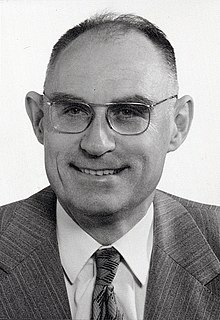Peter Karl Henrici | |
|---|---|
 Peter Henrici in 1982 | |
| Born | 13 September 1923 |
| Died | 13 March 1987 (aged 63) |
| Nationality | Swiss |
| Alma mater | ETH Zürich |
| Known for | Numerical analysis |
| Scientific career | |
| Fields | Mathematics |
| Institutions | University of California, Los Angeles; ETH Zürich; University of North Carolina at Chapel Hill |
| Doctoral advisor | Eduard Stiefel |
| Doctoral students | Gilbert Strang, William B. Gragg |
Peter Karl Henrici (13 September 1923 – 13 March 1987) was a Swiss mathematician best known for his contributions to the field of numerical analysis.
Life
[edit]Henrici was born in Basel and studied law for two years at University of Basel. After World War II he transferred to ETH Zürich where he received a diploma in electrical engineering (1948) and a doctorate in mathematics with Eduard Stiefel as his advisor (1952).
Moving to the USA
[edit]In 1951 he moved to the United States and worked on a joint contract with American University and the National Bureau of Standards. Then, from 1956 to 1962, he taught at University of California, Los Angeles where he became a professor. In 1962 he returned to ETH Zürich as a professor, a position he kept for the rest of his life, though he also held a part-time appointment as William R. Kenan, Jr. Distinguished Professor of Mathematics at the University of North Carolina at Chapel Hill from 1985.[1][2]
Numerical Analyst
[edit]An internationally recognized numerical analyst, who published 11 books and more than 80 research papers, Henrici was also a gifted pianist and a highly regarded teacher.[1] He was an editor of a number of scientific journals, including Numerische Mathematik and Zeitschrift für Angewandte Mathematik und Physik. In 1962, he was a speaker at the International Congress of Mathematicians, and in 1978 he gave the SIAM John von Neumann Lecture.[2]
Peter Henrici Prize
[edit]Every four years since 1999, the Peter Henrici Prize is awarded by ETH Zürich and SIAM for "original contributions to applied analysis and numerical analysis and/or for exposition appropriate for applied mathematics and scientific computing".[3]
Publications
[edit]- Henrici, Peter (1962). Discrete variable methods in ordinary differential equations. Wiley.
- Henrici, Peter (1963). Error propagation for difference methods. SIAM series in applied mathematics. Wiley.
- Henrici, Peter (1964). Elements of numerical analysis. Wiley.
- Henrici, Peter (1974). Applied and computational complex analysis, Volume 1: Power series—integration—conformal mapping—location of zeros. Wiley. ISBN 0-471-37244-7.
- Henrici, Peter (1977). Applied and computational complex analysis, Volume 2: Special functions—integral transforms—asymptotics—continued fractions. Wiley. ISBN 0-471-01525-3.
- Henrici, Peter (1977). Computational Analysis with the HP-25 Pocket Calculator. Wiley. ISBN 0-471-02938-6.
- Henrici, Peter (1986). Applied and computational complex analysis, Volume 3: Discrete Fourier analysis—Cauchy integrals—construction of conformal maps—univalent functions. Wiley. ISBN 0-471-08703-3.
References
[edit]- ^ a b Golub, Gene H.; Varga, Richard S. (1988). "Obituary to Peter Henrici (13 September 1923 – 13 March 1987)". Numerische Mathematik. 52 (5): 481–482. doi:10.1007/BF01400886.
- ^ a b O'Connor, John J.; Robertson, Edmund F., "Peter K. Henrici", MacTutor History of Mathematics Archive, University of St Andrews
- ^ "Peter Henrici Prize (with ETH Zurich)". Society for Industrial and Applied Mathematics. Retrieved 2 June 2011.
External links
[edit]- Peter Henrici at the Mathematics Genealogy Project
- O'Connor, John J.; Robertson, Edmund F. (July 2008), "Peter Henrici", MacTutor History of Mathematics Archive, University of St Andrews